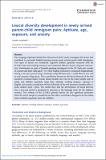Lexical Diversity Development in Newly Arrived Parent-Child Immigrant Pairs: Aptitude, Age, Exposure, and Anxiety

Auteur, co-auteurs
Type de référence
Date
2021Langue de la référence
AnglaisEntité(s) de recherche
Université de Fribourg
Résumé
The Language Aptitude Outside the Classroom (LAOC) study investigates the factors that contribute to successful English-learning among newly arrived parent-child immigrants. Two types of factors are considered: cognitive abilities (aptitude measured with the LLAMA tests and working memory) and contextual-affective factors (exposure and anxiety). Participants are pairs of Spanish-speaking immigrants in the US. Each pair consists of a parent and their child aged 7–16. Their English proficiency is measured longitudinally during a one-year period using a listening comprehension test, a verbal fluency test, and an oral narrative (frog story). This contribution focuses on the lexical diversity of the oral narratives (Guiraud Index). Linear mixed models were run on the entire sample and on adults and children separately using time, aptitude, working memory, exposure to English, and anxiety as predictors of lexical diversity of the oral narratives (random effect = dyad, random slope = time). The results show that the development of lexical diversity over a one-year period is predicted by exposure to the language (and, for the children, anxiety). Two subtests of the LLAMA aptitude battery are also significant predictors when the entire sample is considered, but this effect nevertheless disappears for the adults when modeled separately from the children.Titre du périodique
Annual Review of Applied LinguisticsVolume / tome
41Pagination
76-94URL permanente ORFEE
http://hdl.handle.net/20.500.12162/7360Document(s) associé(s) à la référence
Texte intégral :
Fichier
Accès
Commentaire
Version
Taille
Ouvert
postprint auteur
377.6ko
- Tout ORFEE
- Détail référence



